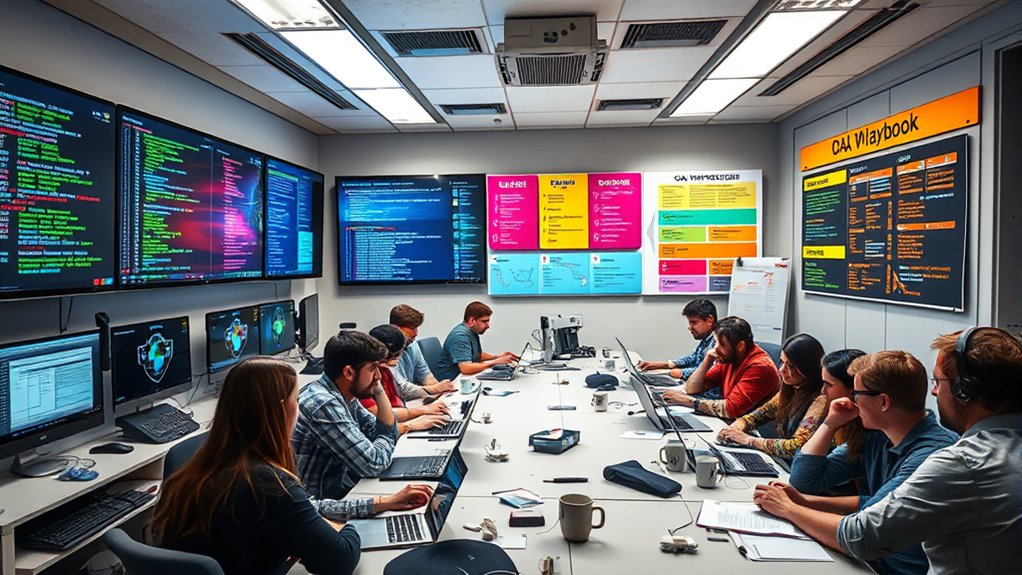To manage a critical release effectively, set up a dedicated QA war room with a mirror environment that’s stable and closely matches production. Establish clear communication protocols using instant messaging and dashboards to guarantee quick info sharing. Conduct daily stand-ups to prioritize tasks and resolve blockers promptly. Automate tests and monitor results to maintain efficiency. This framework creates a resilient, coordinated effort, paving the way for smooth resolution—keep going to discover key strategies for success.
Key Takeaways
- Establish and maintain a stable, synchronized test environment that mirrors production for accurate testing during critical releases.
- Implement clear communication channels to ensure swift, precise information sharing among all team members.
- Conduct daily stand-ups to prioritize tasks, address blockers, and align on testing progress and issues.
- Automate test execution and monitoring to increase coverage, efficiency, and rapid validation under high-pressure scenarios.
- Foster seamless collaboration by integrating testing, monitoring, and communication protocols for quick issue resolution.

Ever wondered how top-quality software teams rapidly identify and resolve critical issues? The secret lies in a well-orchestrated QA war room strategy that hinges on a robust test environment and clear communication protocols. When preparing for a critical release, you need to establish a dedicated test environment that mirrors the production setup as closely as possible. This test environment acts as your battleground, where you can simulate real-world scenarios without risking live data or user experience. It allows your team to uncover issues early, conduct thorough testing, and validate fixes before deployment. Ensuring this environment is stable, scalable, and synchronized with the latest code changes is essential. Regularly updating the test environment and automating deployment pipelines help keep it aligned with the development process, so you’re not chasing outdated data or configurations. Additionally, understanding market dynamics can help anticipate how external factors might influence the urgency or severity of issues during critical releases.
Communication protocols are equally vital in a QA war room. When issues arise, swift and precise communication can make the difference between a quick fix and a prolonged outage. Establish clear channels of communication—whether through instant messaging platforms, dedicated conference lines, or real-time dashboards—that everyone understands and uses consistently. This clarity minimizes misunderstandings and ensures that critical information reaches the right people instantly. During testing, it’s crucial to have a defined process for reporting bugs, sharing status updates, and escalating issues. Use structured templates for bug reports that include detailed steps to reproduce, screenshots, logs, and severity levels. This structured approach reduces back-and-forth and accelerates troubleshooting.
Collaboration is the backbone of an effective war room. Daily stand-ups or quick sync meetings help keep everyone on the same page, prioritize tasks, and address blockers promptly. These meetings should focus on key metrics—such as defect counts, test coverage, and resolution times—so you can gauge progress in real-time. Additionally, leveraging automation tools for test execution and monitoring can free up your team’s bandwidth for more complex problem-solving. When everyone follows the same communication protocols and works within a unified test environment, it streamlines the entire process. It ensures issues are identified quickly, responsibilities are clear, and fixes are validated efficiently.
In essence, the combination of a reliable test environment and well-defined communication protocols creates a resilient framework for your QA war room. It enables your team to act swiftly, share information seamlessly, and resolve critical issues before they reach your users. With these practices in place, you’re better equipped to handle high-stakes releases and maintain the quality your users expect.
Frequently Asked Questions
How Do I Customize the Playbook for Different Project Sizes?
You can customize your playbook by applying scalability strategies tailored to your project size. For smaller projects, streamline testing steps and reduce resource allocation, while larger projects benefit from detailed planning and additional checkpoints. Assess your project’s complexity and adjust the playbook accordingly, ensuring flexibility. This approach helps you manage risks effectively and maintain quality, regardless of project scaling, making your QA process more efficient and adaptable to different project sizes.
What Tools Integrate Best With the QA War Room?
You should look for tools that seamlessly integrate with your test automation and bug tracking systems. Popular options include Jira, which supports bug tracking and integrates with many test automation tools like Selenium and TestRail. These integrations help you streamline communication, track issues in real-time, and automate reporting, ensuring your team stays aligned and responsive during critical releases. Choose tools that fit your workflow and boost efficiency.
How Do We Handle Urgent Hotfixes During a Release?
When handling urgent hotfixes during a release, you should follow established emergency protocols and escalation procedures. Quickly assess the issue’s severity, communicate immediately with relevant teams, and prioritize the hotfix for rapid deployment. Keep stakeholders informed throughout the process. By adhering to these protocols, you guarantee swift resolution without disrupting the overall release, maintaining quality and minimizing downtime during critical situations.
What Metrics Measure QA Success in the War Room?
You’ll want to track bug tracking metrics, like the number of bugs identified and resolved during the war room, to gauge QA success. Additionally, monitor test coverage to make certain critical areas are thoroughly tested. An interesting stat is that a 20% increase in test coverage often leads to a 15% reduction in post-release bugs. These metrics reveal how effectively your team catches issues early and maintains quality during critical releases.
How Can Remote Teams Effectively Collaborate in the War Room?
You can effectively collaborate with remote teams by establishing clear communication protocols and embracing virtual collaboration tools. Use video calls for real-time discussions and chat apps for quick updates, guaranteeing everyone stays aligned. Set regular check-ins to maintain transparency and encourage open feedback. By fostering a culture of clear, consistent communication, you ensure that your remote team works cohesively, even from different locations, to meet critical release deadlines efficiently.
Conclusion
Now that you’ve seen the key strategies, remember—your next critical release hinges on this playbook. Are you prepared to face unexpected challenges head-on? The QA war room isn’t just a command center; it’s where your success or setback unfolds. Stay vigilant, stay agile. Because when the stakes are highest, one misstep could change everything. Will you be ready to lead your team through the chaos and emerge victorious? The choice is yours.









